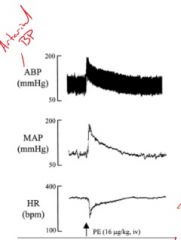![]()
![]()
![]()
Use LEFT and RIGHT arrow keys to navigate between flashcards;
Use UP and DOWN arrow keys to flip the card;
H to show hint;
A reads text to speech;
47 Cards in this Set
- Front
- Back
|
Bradycardia
-definition in dog |
< 60 (avg. for breeds/size)
|
|
|
Bradycardia
-definition in cat |
< 100 (avg. for breed/size)
|
|
|
Bradycardia commonly seen during anesthesia
|
-bradycardia with 2nd Degree AV block
|
|

What is this?
|
-sinus bradycardia with 2nd degree AV block
|
|
|
Is slow heart rate always deleterious?
|
-no, it depends on the demand
|
|
|
Cardiac output =
|
CO = heart rate x stroke volume
|
|
|
Cardiac output
-can usually be improved by: |
-increasing HR
*HR will eventually become to fast to allow for optimal diastolic filling |
|
|
Bradycardic patient
-blood pressure |
-normotensive
or -hypotensive or -hypertensive |
|
|
Bradycardia
-blood pressure can be an indication for: |
-cause of bradycardia
-guide for necessity of treatment |
|
|
Phenylephrine
-effect on ABP, MAP, HR |

-reflex bradycardia
|
|
|
Bradycardia
-causes |
-vagal stimulation ---> inc. PNS tone
-vagomimetic drugs -plane of anesthesia too deep -hypothermia -myocardial hypoxia -hyperkalemia -closed pop-off -increased intracranial pressure (cushing reflex) -cardiac disease |
|
|
Vagomimetic drugs that cause bradycardia
|
-Alpha-2 agonists
-opioids |
|
|
How does hypothermia cause bradycardia?
|
-delayed depolarization of the SA node
-non-responsive to anticholinergics (atropine) |
|
|
How does a closed pop-off valve cause bradycardia?
|
-increased intrapleural pressure
--decreased venous return ---increased aortic pressure ----reflex bradycardia |
|
|
Ways cardiac disease causes bradycardia
|
-AV conduction disturbance
-3rd degree AV block -Sick sinus syndrom |
|
|
When to treat bradycardia
|
-to improve cardiac output
-low blood pressure -underlying cardiac disease -poor tissue perfusion -hypovolemia |
|
|
Bradycardia
-treatment |
-Determine the initiating cause and correct obvious problems
-Anticholinergic |
|
|
Bradycardia
-when to use and anticholinergic to treat |
-if vagal stimulation is the probable cause and no other cause is obvious
|
|
|
Bradycardia
-anticholinergics to treat with |
-atropine
-glycopyrrolate |
|
|
Tachycardia
-definition in dog |
> 180
|
|
|
Tachycardia
-definition in cat |
> 200
|
|
|
Tachycardia
-tolerance to higher heart rate |
-smaller animals can tolerate higher
-underlying heart disease will lower tolerance |
|
|
Tachycardia
-causes |
-excess sympathetic drive
-hypovolemia -pathology |
|
|
Excess sympathetic drive
-caused by |
-high PaCO2
-Pain -Light anesthesia -Sympathomimetics |
|
|
Sympathomimetic drugs
|
-ephedrine
-dobutamine -dopamine -ketamine |
|
|
How does hypovolemia cause tachycardia?
|
-baroreceptor reflex
*not reliable in an anesthetized patient because response is suppressed by opioids |
|
|
Tachycardia
-pathological causes |
-cardiac disease
-hyperthyroidism -pheochromocytoma |
|
|
Tachycardia
-effect on diastolic time |
-decreases diastolic time
|
|
|
Effect of decreased diastolic time on the heart
|
-less time for ventricular filling
-less time for myocardial perfusion (occurs during diastole) --increased myocardial work and need for O2 ---oxygen demand can exceed O2 supply |
|
|
Tachycardia
-treatment |
Treat initiating cause
-insure good analgesia -guarantee good anesthetic depth -IPPV -Increase IV fluid rate if indicated for hypovolemia -Reduce dose of sympathomimetics if indicated -Consider a beta-adrenergic blocker to reduce rate if severe tachycardia |
|
|
How to insure good analgesia to treat tachycardia
|
Opioids
-fentanyl (fast acting) |
|
|
Why may you need to use IPPV to treat tachycardia?
|
-a normalized PaCO2 may decrease the heart rate
|
|
|
Ventricular Extrasystole
-types |
-Premature ventricular complex
-Escape beat |
|
|
Ventricular extrasystoles
-ECG unique finding |
-Wide QRS
- opposite T wave polarity |
|
|
Ventricular Premature Complex
-causes |
-myocardial disease/injury
-pain -hypoxia -acidosis -severe hypothermia -drugs -electrolyte disturbances |
|
|
Drugs that can cause VPCs
|
-xylazine
-thiopental -halothane |
|
|
Electrolyte disturbance that can cause VPCs
|
-high K (hyperkalemia)
|
|
|
Escape beat
-causes |
-normal when the sinus rate is very slow
-the ventricular pacemaker takes over to keep the heart at 30-40 bpm |
|
|
Escape beat
-treatment |
-never suppress or treat (keeping patient alive)
|
|
|
PVCs
-usually occur when |
HR < 30-40 bpm
|
|
|
PVCs
-aka |
-idioventricular rhythm
|
|
|
Accelerated idioventricular rhythm
-define |
VPCs occuring at HR = 40-100 bpm
|
|
|
Ventricular tachycardia
-define |
VPCs when HR > 100 bpm
|
|
|
Ventricular Arrhythmia
-treatment |
-treat initiating cause if possible
-Lidocaine IV -Procainamide or Beta-blocker (esmolol) when lidocaine not working acutely |
|
|
When to give lidocaine CRI for ventricular arrhythmias
|
-> 6/min, 3 in a row, or multifocal
-when compromising blood pressure under anesthesia -if R on T phenomenon is observed |
|
|
Lidocaine
-drug class |
IB antiarrhythmic
|
|
|
Lidocaine
-MOA |
-Na+ channel blocker reduces action potential duration and conduction velocity in myocardium
|

